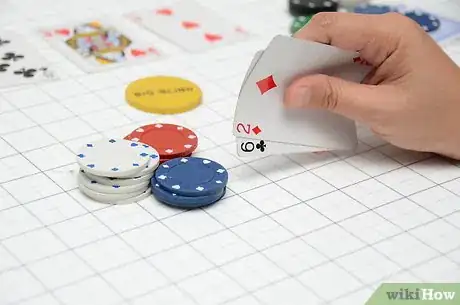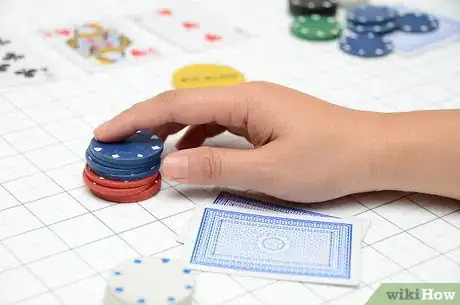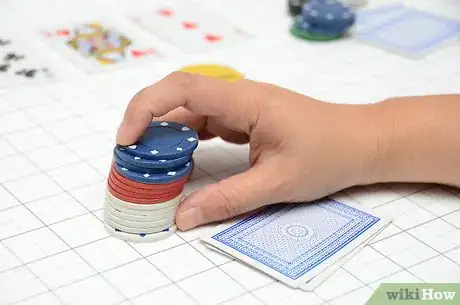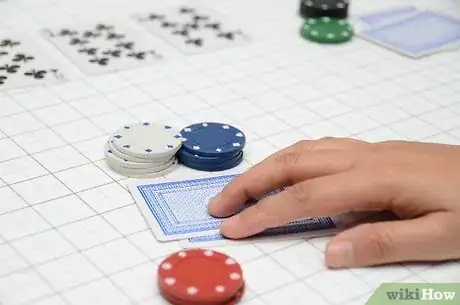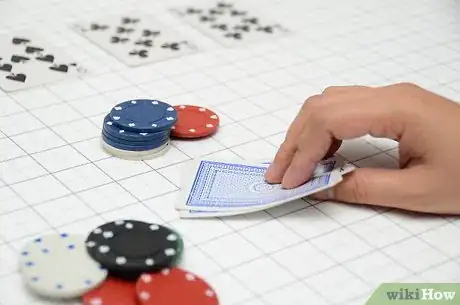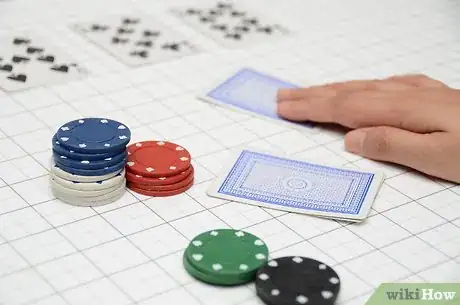wikiHow is a “wiki,” similar to Wikipedia, which means that many of our articles are co-written by multiple authors. To create this article, 10 people, some anonymous, worked to edit and improve it over time.
There are 9 references cited in this article, which can be found at the bottom of the page.
This article has been viewed 85,349 times.
Learn more...
Want to improve your poker game? Knowing how to calculate your odds of building a strong hand is a key step in becoming a good poker player. The calculation used in determining poker odds is influenced by a variety of factors but can be deduced using simple arithmetic. Keep reading for a quick, easy tutorial on how to learn poker percentages, so you can become an even more formidable player.
Steps
Learn the percentages of your favorite poker game.
-
Determining poker odds depends in large part on the game you're playing. For example, the formula for getting a particular hand in 7-card stud is different from that of Texas Hold 'em, arguably the most popular poker game in the world.[1] X Research source
Consider all cogent variables.
-
Think about these variables before calculating hand odds. Hand odds represent the chances of the turn and/or river cards helping you make a good hand.[2] X Research source
- Make your calculations after the flop. In Texas Hold'em, you'll be dealt 2 cards. The dealer will then unveil 3 cards, called the flop, which all players can use to build the strongest hand possible.
- Base your calculations only on the facts available to you. Resist the inclination to make projections on what cards other players may be holding. For the purpose of accurately determining your chance of building a strong hand, only concern yourself with the cards you're holding and the flop.
Determine the number of outs available to you.
-
Outs are cards that directly contribute to the hand you're trying to build. In some cases, you may have only 2 outs, meaning your chances of attaining a desirable hand is remote. Under ideal circumstances, 1 of 15 different outs can complete a strong hand. To tally your outs, you'll need to carefully assess your hand after the flop and then decide what hand you can attain. For example:[3] X Research source
- Nothing: If your hold cards are unsuited and lower than at least 1 of the cards in the flop, you have 6 outs to achieve a pair. For example, say you drew a 5 and a 9. Any of the 3 remaining 5's or 9's in the deck would give you at least a pair. Therefore, you'd have 6 outs for the turn and river.
- Pocket pair: If your hold cards are a low pair (meaning at least 1 of the flop cards is higher, possibly giving another player a higher pair than yours), you have only 2 outs to make 3 of a kind or better.
- 2 overcards: If you're holding 2 cards, say an ace and a queen, that are higher than any of the 3 flop cards, you have 6 outs: the remaining 3 aces and queens.
- Flush draw: A flush draw occurs when your hold cards are suited and the flop contains 2 cards of that same suit. With 4 suited cards in your hand, and 13 cards per suit, you'll have 9 outs to achieve a flush.
- Flush and open-straight draw: To illustrate this scenario, say you've drawn the jack and 10 of diamonds, and the flop is the 9 of spades, and the 8 and 4 of diamonds. You're in a very advantageous position with 15 outs. Any diamond (9 outs for a flush) or any queen or 7, (6 outs total to complete the straight).
Calculate the percentage.
-
Figure out what percentage of the time you will hit your hand with a single card. To determine the chances of the river card being the one you need to complete your hand, subtract your outs from the number of cards remaining. Only consider the cards you have in determining the number remaining. So for the river, there are 46 cards left: 52 -6 (2 hold cards, 3 flops and 1 turn).[4] X Research source
- Divide the result by the number of cards remaining to find your hand percentage.
Find the flop-to-river percentage
-
The flop-to-river percentage is a more difficult calculation to find. It involves 2 cards in separate draw: the turn and river.[5] X Research source
- To find the hand percentage for a flush draw, subtract the number of outs from the number of cards remaining for the turn (47-9) and divide by 47. The quotient is 0.81.
- For the river, subtract the outs (9) from the cards remaining (46) and divide the result by 46. This quotient is 0.80.
- Multiply the 2 quotients. The result is 0.65.
- Subtract 0.65 from 1 to find the hand percentage. The result is 0.35, meaning you have a 35 percent chance of getting a flush off a flush draw.
Turn your hand percentage into an odds ratio.
-
This is an important step in becoming an effective Texas Hold'em player. The hand odds will need to be compared to the pot odds to determine whether to stay in the game. To find hand odds, follow this procedure.[6] X Research source
- Express your hand percentage as a whole number. For example, 24 percent becomes 24.
- Divide 100 by this number. The result is 4.17.
- Round the result to the nearest whole number, which in this example is 4.
- Subtract 1 to find the ratio. The hand odds in this example are 3-1.
Determine the pot odds.
-
The pot odds represent the number of times out of 100 you need to achieve a hand to break even. Professional poker players compare the pot odds to the hand odds before calling bets on the turn and river. When pot odds exceed hand odds, a solid betting situation exists.[7] X Research source
- After the flop, there is $50 in the pot. The first player raises $10.
- To stay in the game, you must match the raise, or "call" the bet.
- A $10 bet into a $50 pot represents pot odds of 5-1.
- Bet into the game if your hand odds are better (lower) than the pot odds. Otherwise, fold.
You Might Also Like







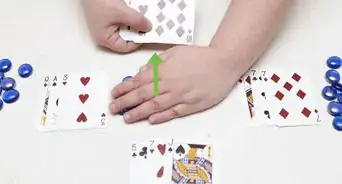





References
- ↑ https://www.beatthefish.com/poker-strategy/texas-holdem-odds/
- ↑ https://www.yourhandsucks.com/poker-calculators/
- ↑ http://www.thepokerbank.com/tools/odds-charts/percentage/
- ↑ https://www.tightpoker.com/poker_odds.html
- ↑ http://www.pokerology.com/lessons/drawing-odds/
- ↑ http://www.thepokerbank.com/tools/odds-charts/ratio-percentage/
- ↑ https://www.cardschat.com/odds-for-dummies.php
- http://www.tightpoker.com/poker_odds.html
- http://www.beatthefish.com/poker-strategy/texas-holdem-poker-hands.html
